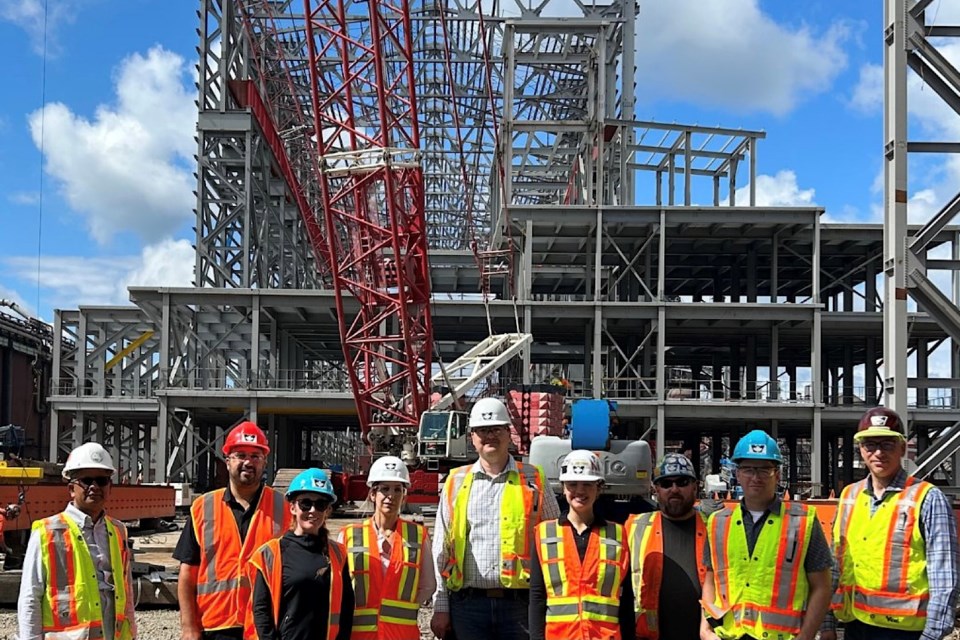Algoma Steel Group Inc. says it has made cleaning up its air quality issues a key priority, but the change can't happen immediately and it will depend on sufficient electricity being available to power its still-under-construction electric arc furnaces.
"With construction well underway, Algoma anticipates the facility to come online by the end of 2024," the Sault Ste. Marie company states in its inaugural environmental, social and governance (ESG) report, issued on Sept. 12.
"As more electrical power becomes available, Algoma will be able to progressively transition away from basic oxygen steelmaking."
"But it cannot happen overnight," the ESG report said.
In recent months, ESG reports have become a gold standard used by many socially conscious investors to evaluate a company's performance on sustainability and ethical issues.
Numerous mutual funds, brokerages and robo-advisers offer ESG-based investment products.
The growth of these products has encouraged businesses to increasingly emphasize their ESG performance when competing for capital.
Algoma Steel has been criticized for having dangerously high levels of carcinogenic emissions.
"It is deeply concerning to see that despite the existence of regulations, the Algoma Steel mill has been allowed to operate in a manner that is harmful to the health and well-being of the people living in the local area," said a letter signed six months ago by 38 Algoma University faculty members.
"This has been going on for far too long, and it is time for the government to take immediate action to enforce the regulations that are in place," the professors said.
"The reality is no coal-based steelmaking facility in Ontario today is capable of meeting the current Ontario Regulation Standards (known as 419/05)," Algoma Steel said in today's ESG report.
"That is why the government provides site-specific and technical standards to allow industries like ours whose assets predate modern standards to embark on an action plan to reduce air emissions and monitor progressive improvements towards the ultimate goal of green steel production.
"By the end of 2024, Algoma expects to begin commissioning its first EAF [electric arc furnace]. The earlier stages of our EAF transformation will involve Algoma operating in a hybrid mode with both EAF and basic oxygen steelmaking.
"As more electric power becomes available, we will work towards a complete transition to EAF steelmaking and shut down our coke batteries and blast furnace. This transition will significantly shrink our environmental footprint with improvements to air, water, waste, and noise.
"Site-specific or technical standards are practical solutions, developed by the government as compliance mechanisms under Reg. 419/05, that allow Algoma to continue to produce steel, generate funds to invest in new technology, and protect livelihoods related to this industry, while urgently transforming our business for a greener tomorrow.
"As a result of the progressive shutdown of cokemaking facilities in the transition to EAF steelmaking, a substantial reduction or elimination of benzene, benzo(a)pyrene, particulate matter, and sulfur dioxide emissions is expected.
"When we complete our EAF transformation, we expect to meet the general Ontario air quality standards and no longer require site-specific or technical standards for any of the four compounds, but it cannot happen overnight.
"The site-specific or technical standards allow for a period of transition as we work with our existing technology. We continue to maintain our assets and pursue continuous improvements to minimize our air quality impacts.
"The site-specific standards for Algoma are based on complex computer models that predict air emissions. In 2021, the model used to predict potential maximum emissions changed. While Algoma’s actual emissions did not change, with the changes to the model, our site-specific standards had to be amended to reflect the new model.
"We continue to monitor the situation and are committed to providing the community surrounding our operations with regular updates on our continued efforts to improve air emissions performance. Continuing to reduce our air quality impact remains a top priority," the company said.
Algoma said it's committed to complying with all existing permits during the transition, while continuously improving its performance, concentrating on contaminants needing site-specific or technical standards.
How long could that take?
"We anticipate needing our internal natural gas power plant until regional power systems are upgraded. Regional electrical grid updates sufficient to meet the energy demands of our future EAF operations are not expected until 2029 or later.
"Currently, we are pursuing a local electricity transmission infrastructure upgrade and technical contingency solution to allow us to access more power sooner from the grid in Sault Ste. Marie.
"Once our EAFs are in operation, we will begin by operating in hybrid mode to limit our power requirements until more grid energy is available. Hybrid mode will include the operation of our No. 7 blast furnace at a reduced level."
Last month, Sault Ste. Marie Mayor Matthew Shoemaker expressed concern that the province's Independent Electricity System Operator (IESO) won't allow the Sault or other northern communities to participate in the current long-term request for proposals for generating capacity.
"Algoma Steel's electric arc furnaces are going to use all of the power that comes into our community," Shoemaker said.
"We will have no ability to attract any commercial establishment of any significant power usage until the grid is upgraded, which IESO is telling us will not be until after 2029-ish.
"So for the next six years, we have no capacity to attract businesses if we don't have the upgrade of the new transmission lines prioritized, or generation capacity developed locally to counter that," the mayor said.
Algoma's ESG report concedes that the company is the second largest industrial greenhouse gas emitter in Ontario.
"The transition to a low-carbon economy poses several risks to our ability to remain a resilient steel producer in a net-zero economy. These risks include policy and legal, reputational, market, and technology risks," the company said.
"Over the short- and medium-term, carbon pricing/ emissions-limiting regulations will continue to drive up operational costs, especially if we do not continue to reduce greenhouse gas emissions across our operations."
— SooToday




